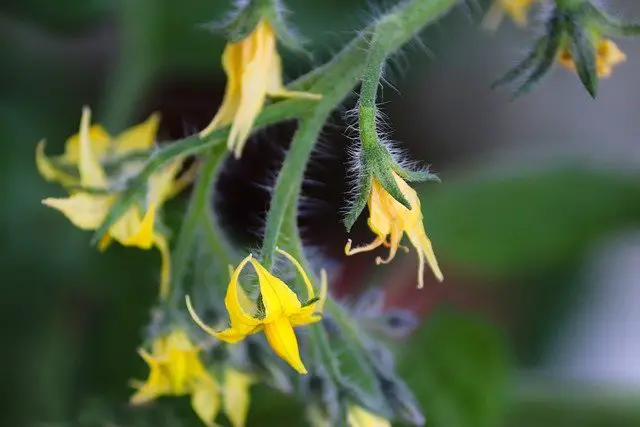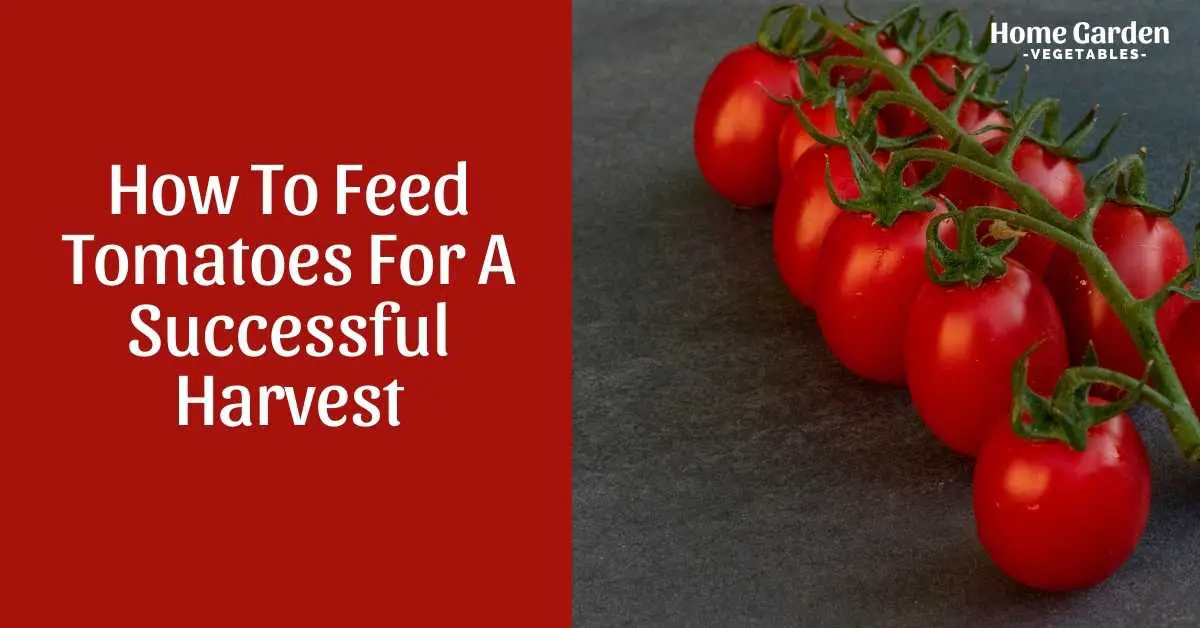Harvesting baskets of ripe, juicy tomatoes are the ultimate goal when you plant a tomato crop. To make the most out of your crop and to ensure a successful harvest, you need to understand a little about their requirements, especially their watering and feeding preferences. In this article, I will explain how to feed tomatoes so you can have delicious homegrown tomatoes.
In a nutshell, tomatoes are heavy feeders. They’ll need plenty of nutrients throughout the growing season to do well. But what kind of fertilizer is best for your tomato crop? How often should you be feeding your tomato plants and how best to feed them? Keep reading, and you’ll find out all you should know about fertilizing tomatoes.
Reader Poll: What online courses would interest you?

What Kind Of Fertilizer Is Best For Tomatoes?
The best fertilizer for your tomato crop significantly depends on the nutrient content of the soil that you start off with. For this reason, it’s best to have a soil test performed on the land where you plan on planting tomatoes beforehand.
If you have a balanced soil or one that’s lacking in nitrogen, it’s better to go for a fertilizer low on nitrogen and a bit high on phosphorous. A 5-10-10, or a 5-10-5 mix would be ideal in this case.
On the other hand, if the land is a bit lacking in nitrogen, it will help to choose a balanced fertilizer to feed your crop. A 10-10-10 fertilizer mix would suit your tomato crop perfectly in this case.
Subscribe to our newsletter!
Even if a soil test isn’t possible, assume a balanced soil and use a fertilizer that has low nitrogen content. A fertilizer with higher nitrogen content will result in a smaller yield.
Nutrient Requirements For Each Phase
While tomato plants are heavy feeders, their nutrient requirements vary according to the specific growing phase they are in. it pays to know what elements they require during each phase to be able to feed them correctly.
- Transplanting
Transplanting is an excellent time to fertilize the plants since you can get the required nutrients close enough to the roots. At this stage, the tomato seedlings need nitrogen to grow stronger stems and foliage. However, if you have already incorporated compost into the soil in advance, there’s no need to supplement with additional nitrogen. Too much nitrogen can burn the plants.
The seedlings can also benefit from phosphorus at this stage. Adding a little bone meal to the bottom of the planting holes before transplanting the seedlings can cover the phosphorus requirements during early growth.
- Growth Phase
During the period that the tomato seedlings are growing actively, the plants are using up nitrogen from the soil. Rich soil doesn’t need much supplemental nitrogen during this phase. However, if you notice yellowing leaves towards the bottom of the plant, you may supplement with a light dose of a nitrogen-based fertilizer.
- Fruiting
Developing fruits need potassium. Fertilize with a potassium-based fertilizer and continue feeding the same formula until the end of the season. Make sure you don’t give the plant any nitrogen at this stage since it can trigger green growth and take the energy away from the developing flowers and fruits.
What About Organic Fertilizers?
Chemical and organic fertilizers work equally well, but many farmers prefer the latter. With organic fertilization, you have the satisfaction of yielding a harvest that’s a result of nothing but natural means. Also, it’s environmentally friendly, which is another huge plus.
Organic tomato fertilizers are created from a number of different products like bone meal, alfalfa meal, and blood. They will gradually release nitrogen, phosphorous, potassium, and micronutrients in the soil to keep your tomato plants nourished.
When To Feed Tomatoes?
Give the tomato plants their first feed at the time of planting them. Water the freshly planted seedlings with a weak fertilizer solution. If you’ve used fresh compost at the time of planting, you might not need to fertilize the young plants at all. Freshly composted soil will have enough nutrients to keep the plants well fed for the initial growth stages.
Once you’ve fed the plants at the time of planting, wait for the flowers to set fruit before the next fertilization. Once the fruits appear on the plants, start fertilizing it weekly or fortnightly until the plant dies with the start of winter. Most fertilizers are to be applied at the time of watering as a dilute solution.
How To Feed Tomatoes?
Be careful when fertilizing your tomato plants; it’s quite easy to overfeed them. Overfeeding results in problems rather than benefits, which we’ll discuss in a bit.
Feeding young plants
- If you decide to feed tomato seedlings, do so as soon as you transplant them into the ground.
- Instead of the dosage that’s recommended on the fertilizer packaging, mix only half in the same amount of water so that you have a very dilute solution.
- If you’re growing in a pot, it’s better to bottom-feed this solution to the seedlings. Feeding at the bottom will prevent the plant from being overwatered and other problems like fungus gnat. However, when feeding in-ground tomato plants, bottom-feeding isn’t a possibility so you’ll have to be careful not to overwater them.
Feeding mature plants
Most tomato feeds are designed for the fruiting stage only. Between the time of planting and the fruiting stage, no feeding is necessary. However, if you do feel the need to feed your tomato plants during this time, do so with general-purpose plant food. Also, give at least two week’s time between the first feed and the application of general-purpose feed.
Follow the guidelines on the fertilizer package to prepare a feeding solution for the fruiting stage. Use the same dosage as prescribed on the package. You’ll generally need 1 tablespoon of fertilizer per gallon of water.
Foliar feeding is also a technique that you can consider if your tomato plant needs immediate attention. Spraying the fertilizer solution directly to the plant leaves allows it to be absorbed into the plant’s system quickly for a quick fix. However, make sure that the fertilizer you choose is suitable for foliar feeding. Read the instructions on the packaging to learn more.
Use Of Granular Fertilizers
When using granular plant feed at the time of planting, mix it into the soil at the bottom of the hole that you dig for the seedling. Over the fertilized soil, add a thin layer of unfertilized soil before placing the young plant over it. Make sure fertilizer doesn’t contact the plant roots directly.
Once the fruit sets, water the plants well before applying granular fertilizer. Watering ensures that the tomato plants don’t absorb too much fertilizer; otherwise, they may burn. Once you have watered the plants, spread it over the ground, maintaining a 6-inch distance from the plant base. Applying it too close to the plant can, again, burn it.
Problems Of Overfeeding
Overfeeding is a serious problem associated with tomato plants. Overfeeding at the time of transplanting the seedlings can easily damage the plant roots and cease plant growth altogether.
Mature plants don’t respond well to overfeeding either. Feeding them too much or too often can result in greener plants, with more leaves and fewer fruits. Leaf curl is another problem that you may notice with overfed tomato plants.
In this article, I have covered everything you need to know about how to feed tomatoes. If you have any questions or comments or your own tips on feeding please contact me.
In short, less is more when it comes to tomato fertilization!
The Importance Of Rich Soil
Fertilizers are only supplements. They can replenish the lost nutrients of the soil to cover the needs of the crop. However, a thriving garden starts with rich soil. Whether you’re growing tomatoes, or any other vegetable, you can’t overlook the necessity of a rich soil. Make sure you prepare the garden bed well in advance before planting the tomato seeds or seedlings. Tomato seedlings are hungry plants. They’ll need lots of nutrients and a light, well-drained soil to thrive.
Gardeners often prepare the soil around autumn before the planting season in spring. If the soil is compacted, break it up and turn it over with a garden spade or shovel. Roots won’t be able to develop properly in compacted soil no even if you continue adding fertilizers throughout the growing season.
After breaking up the soil, amend it with several inches of compost or well-composted manure. You can also add powdered eggshells at this point to provide calcium to the soil. Calcium is an important nutrient for the tomatoes and can prevent them against a common problem called blossom end rot.
Mix in all the amendments nicely to incorporate them evenly into the soil. Within the next few months, the organic matter will break down as a result of microbial activities within the soil layer, releasing the much-needed nutrients into the soil. By the time the tomato seedlings are in the ground, the soil will be brimming with all the essential elements to feed the seedlings and help them develop into stronger plants.


the best website ever